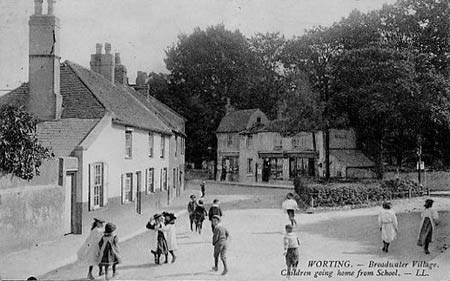First published in the West Sussex Gazette 17th June 1993 Over the course of the last two weeks this column has featured the childhood memories of Cyril Tickner, now it's the turn of his wife Grace, who comes from a family of cobblers (read the previous article). Her brother Arthur March was a cobbler and shoemaker for 43 years in Park Road, his premises being next to what was Searles Garage, now Denton Motors, where there was a wooden door leading from the road with a sign above it announcing 'The hole in the wall', so-called because his workshop was so tiny. 'It was a regular place of call for travellers on the road,' said Grace, 'Arthur would sometimes give them a shilling when they needed it.' This small cobbler's workshop was up and going in the 1890s, the owner then being a Mr Paty. It was from him that Arthur started to rent it for about five shillings a week in 1926 until eventually he decided to buy it. The shoe trade had been handed down through generations of the March family. Arthur's grandfather John March was a cobbler cum shoemaker who originally came from Storrington to Worthing, where, from the mid 19th century he practised his trade in a large workshop at the rear of what used to be Whittington's shoe shop opposite Steyne Gardens. Grace recalls going in to see her grandfather there in about the year 1912 when she was just a little girl, 'He always wore a thick leather apron and would give me a penny.' Her uncle Harry March was also a cobbler, his shop being on the south side of Chatsworth Road about four doors up from the Fountain pub, in premises that have since been demolished. His brother Albert was a cobbler too, he set himself up in business at Fishersgate some six miles east of Worthing. Grace has fairly good recall for she can remember when the very first open-top petrol bus drove up to Broadwater, only going as far as the church to begin with. Husband Cyril, born in Broadwater in 1905 next to the Southdown pub in Northcourt Road recalls even further back: 'I can remember the last of the horse-drawn omnibuses galloping past Northcourt Road on its way up to Broadwater. It belonged to Mr Town, and the conductress was a Mrs Stanbridge who lived round the corner from me in Queens Street. At that time there was an empty field where Caffyns garage is now on the corner of Queens Street.' 'I remember a farm next to Broadwater Church where Tribes now stands, and opposite was another part of the same farm, all worked by two the two brothers Prince who owned a corn shop in High Street. Gladys Prince, the daughter of one of them, took me to see the farm horse when I was quite young, about seven years old. Being the same age as each other and living in the same neighbourhood, we were good playmates. 'At that time a small post office (now demolished) stood at the entrance to Woollard & Newington's timber yard in King Street (now Alsfords) owned by a German named Eufinger who had a son in the British Army.' This was 1914 and Cyril was then nine years old. 'I also remember a dancing bear which got down from a low cart and performed opposite Luxfords shoe repairers in King Street. Troops billetted in the area used a local hall as a mess room, according to Cyril. ' I can recollect slabs of beef being thrown off a cart and on to the pavement outside the Queen Street Mission Hall to feed the East Surrey Regiment. 'From this hall to South Farm Road were all allotments then, but after the 14-18 war they were developed into a Corporation housing estate. 'Only a short piece of St Lawrence Avenue then existed and on the corner of South Farm Road was a pair of wooden gates, and I watched what could have been the last lot of cows to walk through the mud. There are now a row of shops there. 'The ground opposite the cemetery in South Farm Road was very stony, the flints being collected for road building. This same ground had a three foot wall to it, and in one place nearly opposite the cemetery gates was a lower part made to act as style for a footpath to Tarring Church. When we lived in Cranleigh Road after the 39-45 war, part of that path was still to be seen, next to my allotment; Wiston Avenue being a few yards away. Such an interesting couple: Grace mentioned a pond she remembers at Broadwater Green; while Cyril remembered when the Grove Lodge corner of Broadwater Green flooded and had a boat on it. 'There was a deep pit there,' he recalled. 'Where the roundabout is now there was a little cottage in the midst of a grove of trees where a man called Humphrey lived alone. He worked as a stonemason for Tates in North Street.' In 1919 when Cyril was working for Harry Hills, a builder and undertaker, earning the grand sum of five shillings a week, he recalls how, as part of house decorating, the carpets had to be taken up and cleaned in the following manner: 'I used to have to push carpets in a truck, lay them upside down on clean grass at either side of Grand Avenue which then was nothing more than a flint road and beat the living daylights out of them!' Cyril and Grace, who have known one another for more than 70 years celebrated their diamond wedding anniversary last year. | 
Children on their way home from school, photographed in Edwardian times from Broadwater Street West looking towards Broadwater Street East. Well-concealed behind the trees lies the church which today is a conspicuous and noted landmark.
|
| 

